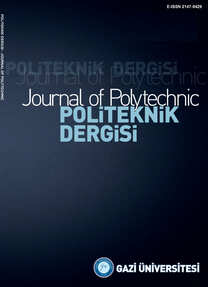Quadrotor İtme ve Tork Katsayılarının Optimizasyonu ve Matlab/Simulink ile Simülasyonu
İHA, Quadrotor, PID Kontrol, Uçuş Dinamiği
Optimization of Quadrotor’s Thrust and Torque Coefficients and Simulation with Matlab/Simulink
UAV, quadrotor, PID control, flight dynamics,
___
- Referans1 Chen X., Zhang. M., and Yang Y.-D., “Study of an Intelligent PID Attitude Controller for UAV”, Journal of Nanjing University of Aeronautics & Astronautics, 6, 76-83, 2003.
- Referans2 Lee D., Kim H. J., and Sastry S., “Feedback linearization vs. adaptive sliding mode control for a quadrotor helicopter”, International Journal of Control Automation and Systems, 7(3), 419-428, 2009.
- Referans3 Nicol C., Macnab C. J. B., and Ramirez-Serrano A., “Robust neural network control of a quadrotor helicopter”, Canadian Conference on Electrical and Computer Engineering, 1, 1233-1237, 2008.
- Referans4 Santos M., López V., and Morata F., “Intelligent fuzzy controller of a quadrotor”, IEEE International Conference on Intelligent Systems and Knowledge Engineering 141-146, 2010.
- Referans5 Madani T. and Benallegue A., “Adaptive control via backstepping technique and neural networks of a quadrotor helicopter”, IFAC Proceedings Volumes, 41(1), 6513-6518, 2008.
- Referans6 Bouabdallah S. “Design and control of quadrotors with application to autonomous flying”, Ph.D Thesis, École. Polytechnique and Federale De Lausanne, Siegwart, Roland, 2007.
- Referans7 Tomashevich S. and Belyavskyi A., “Passification Based Simple Adaptive Control Of Quadrotor”, IFAC-PapersOnLine, 49(13), 281-286, 2016.
- Referans8 Shao X., Liu J., and Wang H., “Robust back-stepping output feedback trajectory tracking for quadrotors via extended state observer and sigmoid tracking differentiator”, Mechanical Systems and Signal Processing, 104, 631-647, 2018.
- Referans9 Cabecinhas D, Cunha R., and Silvestre C. “A trajectory tracking control law for a quadrotor with slung load”, Automatica, 106, 384-389, 2019.
- Referans10 Ryll M., Bulthoff H. H., and Giordano P. R., “A Novel Overactuated Quadrotor UAV: Modeling, Control and Experimental Validation”, IEEE Transactions on Control Systems Technology, 23(2), 540-556, 2015.
- Referans11 T. P. Shenoy, K. Praveen Shenoy, L. Khan, S. Aziz, S. Afran, and K. Kumar, “Design and development of a novel triphibian quadcopter,” International Journal of Engineering & Technology, 7(2.21), 1-4, 2018.
- Referans12 Oosedo A., Konno A., Matsumoto T., Go K., Masuko K., and Uchiyama M., “Design and attitude control of a quad-rotor tail-sitter vertical takeoff and unmanned aerial vehicle”, Advanced Robotics, 26(3-4), 307-326, 2012.
- Referans13 Nandakumar G., Srinivasan A., and Thondiyath A., “Theoretical and Experimental Investigations on the Effect of Overlap and Offset on the Design of a Novel Quadrotor Configuration, VOOPS”, Journal of Intelligent & Robotic Systems, 92(3-4), 615-628, 2018.
- Referans14 Badr S., Mehrez O., and Kabeel A. E., “A novel modification for a quadrotor design,” International Conference on Unmanned Aircraft Systems, 702–710, 2016.
- Referans15 Leishman, J. G., “Principles of helicopter aerodynamics”, Cambridge Aerospace Series, Cambridge University Press, 2016.
- Referans16 Ercan Y., “İleri dinamik”, ISBN: 978-605-030-981-2, 2014.
- ISSN: 1302-0900
- Yayın Aralığı: 6
- Başlangıç: 1998
- Yayıncı: GAZİ ÜNİVERSİTESİ
Çatlağın Re-entrant ve Balpeteği Yapıların Mekanik Davranışlarına Etkisinin Sonlu Eleman Analizi
Yüksek Gerilim Hatlarındaki Arızalarda Mikroşebekenin Otonom Çalışması ve Arızanın Minimizasyonu
Mustafa BURUNKAYA, Cemal YILMAZ, Furkan ÜSTÜNSOY, Sadık YILDIZ, H.Hüseyin SAYAN, Ercan Nurcan YILMAZ, Mithat BULUT
Ecotoxicity Study of Iron Oxide Nanoparticles on Chlorella Sp. and Daphnia Magna
BURCU ERTİT TAŞTAN, İlknur KARS DURUKAN, MEHMET ATEŞ
Ses Komutları ile Media Player Kontrolü İçin Bir Uygulama
Abdullah ELEN, Emre AVUÇLU, Ayhan ÖZÇİFÇİ
Elif DURNA, Goncagül KOZ, NEVİM GENÇ
Low Concentration NO Gas Detection Of SnO2 And Zn0.50Sn0.50O Sensors
Irmak KARADUMAN ER, Tuğba ÇORLU, Memet Ali YILDIRIM, Aytunç ATEŞ, SELİM ACAR
Göçme Yükü Etkisindeki Köprü Kemerlerinin Yapısal Davranışı
GÖKHAN BARIŞ SAKCALI, Alper GÖNÜL, İsmail Enes PARLAK
PEO Kaplamalara CeO2 Nanopartikül İlavesinin Korozyon Davranışına Etkisi
Ahmet Melik YILMAZ, Fatma SONGUR, Ersin ARSLAN, Burak DİKİCİ
Analyzing the Environmental Effects of Conventional and Condensing Combi Boilers Using Natural Gas
